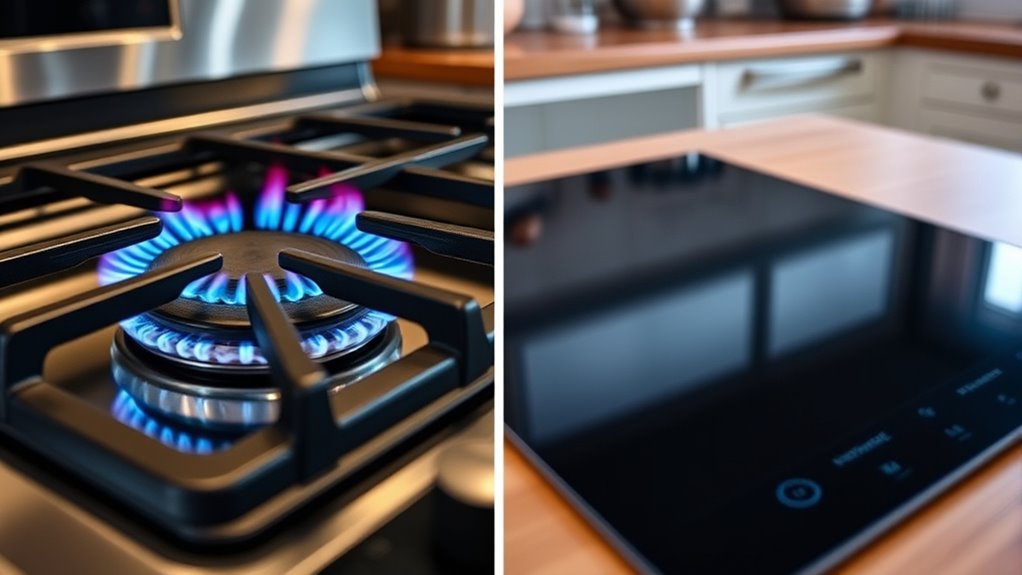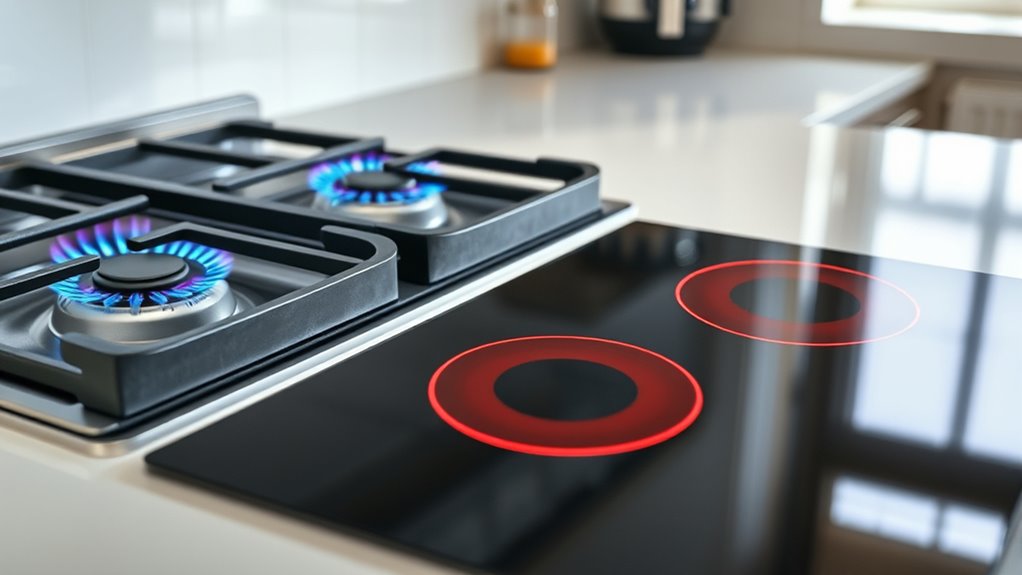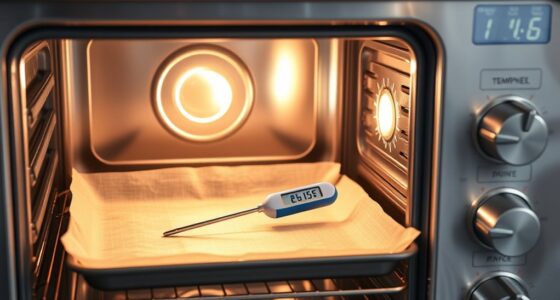Gas stoves give you instant heat control and quick responses, making them great for precise cooking, but they come with safety concerns like open flames and gas leaks. Electric stoves are safer, easier to clean, and more energy-efficient, though they might respond slower and be less versatile for certain techniques. Each has its benefits and drawbacks; if you want to explore more, you’ll find helpful details on safety, efficiency, and features to contemplate.
Key Takeaways
- Gas stoves offer instant heat control and responsiveness, ideal for precise cooking adjustments.
- Electric stoves are generally safer with no open flames, reducing fire and gas leak risks.
- Electric models tend to be more energy-efficient and cost-effective long-term due to better heat conversion.
- Gas stoves require regular maintenance and proper ventilation for safety and efficiency.
- Modern electric stoves include smart features and advanced heating methods for improved control and energy savings.
Advantages and Disadvantages of Gas Stoves

Gas stoves have long been favored by professional chefs and home cooks alike because they offer instant heat control and responsiveness. However, safety concerns are a significant drawback. Open flames increase the risk of gas leaks, fires, and carbon monoxide buildup if not properly maintained. You need to stay vigilant with regular inspections and proper ventilation. When it comes to energy efficiency, gas stoves are generally less efficient than electric options. Much of the heat produced is lost around the sides of the pan, wasting energy. While they provide quick heat adjustments, this energy loss can lead to higher utility bills over time. Weighing safety and efficiency, you might find gas stoves less suitable, especially if safety precautions aren’t strictly followed. Additionally, ensuring proper ventilation and maintenance is essential to mitigate health and safety risks associated with gas appliances. Proper installation practices also play a critical role in maintaining safe operation. Moreover, fuel type can influence both the safety and cost-effectiveness of your cooking setup.
Advantages and Disadvantages of Electric Stoves

Electric stoves offer a different set of benefits and challenges compared to gas models. One major advantage is energy efficiency; electric stoves convert more electricity into heat, often making them more cost-effective over time. They also provide consistent heat, which improves cooking precision—you can control temperature more accurately. However, electric stoves tend to heat up and cool down more slowly, limiting their responsiveness. This can be frustrating when you need quick adjustments. Additionally, electric coils or glass-ceramic surfaces can be less durable and harder to clean. While they’re generally safer since they don’t produce open flames, they may not be ideal if you prefer instant heat control. Furthermore, the integration of European cloud innovation in electric appliances is enhancing smart control features, making some models more responsive and energy-efficient. As technology advances, these smart features are becoming increasingly accessible to home cooks. Understanding the electric stove technology can help you make better decisions when choosing a model. For example, newer models incorporate wave and wind heating methods, which can improve responsiveness and efficiency. Modern electric stoves also often include reliable safety features, which can provide extra peace of mind during use. Overall, electric stoves suit those who value precision and energy efficiency but are willing to accept slightly less responsiveness.
Frequently Asked Questions
Which Stove Type Is More Energy-Efficient for Everyday Cooking?
Electric stoves are generally more energy-efficient for everyday cooking because they convert more energy directly into heat, reducing overall energy consumption. They also tend to have lower operational costs since electricity is often cheaper than gas, especially with modern models. You’ll find electric stoves easier to maintain and clean, which can save you time and money in the long run. Overall, electric options typically offer better efficiency and lower ongoing expenses.
How Do Gas and Electric Stoves Impact Indoor Air Quality?
Like a detective uncovering clues, you’ll notice gas stoves can impact indoor air quality with emissions like nitrogen dioxide and carbon monoxide, raising air quality concerns. Electric stoves, on the other hand, don’t produce these fumes but may generate indoor pollution from cooking oils and smoke. Proper ventilation needs are essential for both, especially if you cook frequently, to keep your home’s air safe and fresh.
Are There Safety Concerns Unique to Each Stove Type?
You should be aware that gas stoves pose safety risks like gas leaks, which can cause fires or explosions if not properly maintained. Electric stoves, on the other hand, carry a risk of electrical fires or shocks if wiring isn’t correctly installed or if appliances are damaged. Regular inspections and proper usage help mitigate these hazards, ensuring a safer cooking environment regardless of your stove type.
What Are the Long-Term Maintenance Costs for Gas Versus Electric Stoves?
Long-term, electric stoves usually cost less in maintenance because they have fewer moving parts, and repairs are less frequent. Gas stoves might incur higher repair costs over time due to issues with burners or valves, and installation costs can be higher, especially if gas lines need upgrades. You’ll find electric stoves generally more economical for ongoing maintenance, while gas stoves might need more frequent repairs and higher initial setup expenses.
Can I Use Both Stove Types Interchangeably in the Same Kitchen?
You can use both stove types interchangeably in your kitchen, but you’ll face some installation challenges with dual stove compatibility. Make certain your kitchen has the necessary electrical outlets and gas lines, and consider professional help to prevent safety issues. While it’s possible, mixing gas and electric stoves requires careful planning, so weigh the convenience against potential costs and complexity before making the switch.
Conclusion
Choosing between gas and electric stoves depends on your cooking style. For example, imagine a home chef who switches to electric for easier cleanup but misses the instant heat of gas. Ultimately, weighing the pros and cons helps you find the best fit. Whether you prioritize control or convenience, understanding these differences guarantees you make a choice that enhances your culinary adventures every time you cook.









